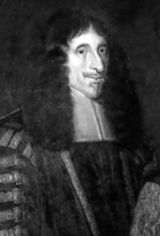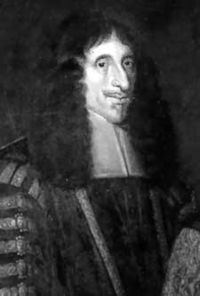
John Campbell, 1st Earl of Loudoun
Encyclopedia

Earl of Loudoun
Earl of Loudoun , named after Loudoun in Ayrshire, is a title in the Peerage of Scotland. It was created in 1633 for John Campbell, 1st Earl of Loudoun, along with the subsidiary title Lord Tarrinzean and Mauchline....
(1598–1662) was a Scottish
Scotland
Scotland is a country that is part of the United Kingdom. Occupying the northern third of the island of Great Britain, it shares a border with England to the south and is bounded by the North Sea to the east, the Atlantic Ocean to the north and west, and the North Channel and Irish Sea to the...
politician. He was the eldest son of James Campbell of Lawers
Lawers
Lawers is a village situated in rural Perthshire, Scotland. It lies on the banks of Loch Tay and at the foot of Ben Lawers. It was once part of a vibrant farming industry in the area....
John Campbell married Margaret, the daughter of George Campbell around 1620. Margaret was heir to her grandfather Hugh Campbell, first Lord Loudoun, who resigned his peerage in John's favour. As the second Lord Loudoun, Campbell inherited the Loudoun estates in Ayrshire; he was granted the earldom of Loudoun by King Charles I in 1633.
Loudoun was among the noblemen who supported the protests against the King's attempts to introduce innovations into the Scottish church and at his interference in the traditions of the Scottish nobility. Naturally eloquent and persuasive, Loudoun emerged as a leading spokesman for the Covenanter movement at the Glasgow Assembly of 1638. In July 1639, he was a commissioner at the treaty negotiations held at Berwick after the First Bishops' War; the following year he was one of the Scottish commissioners sent to London to negotiate with the King. In March 1640, a letter was discovered from the Covenanters to Louis XIII of France requesting his support. King Charles regarded the request as treasonous. As one of the seven signatories of the letter, Loudoun was arrested in London on 11 April and imprisoned in the Tower.
He was released after promising to attempt to persuade the Covenanters to disband the army that was gathering in Scotland. However, Loudoun accompanied the army when it invaded England during the Second Bishops' War and once again played a leading role in the treaty negotiations at Ripon and London.
He resisted Charles I
Charles I of England
Charles I was King of England, King of Scotland, and King of Ireland from 27 March 1625 until his execution in 1649. Charles engaged in a struggle for power with the Parliament of England, attempting to obtain royal revenue whilst Parliament sought to curb his Royal prerogative which Charles...
, and in 1641 was appointed Lord Chancellor of Scotland
Lord Chancellor of Scotland
The Lord Chancellor of Scotland was a Great Officer of State in pre-Union Scotland.Holders of the office are known from 1123 onwards, but its duties were occasionally performed by an official of lower status with the title of Keeper of the Great Seal...
, an office which he held for 19 years, until he was deposed at the restoration; and was also First Commissioner of the Treasury
Treasurer of Scotland
The Treasurer was a senior post in the pre-Union government of Scotland, the Privy Council of Scotland.The full title of the post was Lord High Treasurer, Comptroller, Collector-General and Treasurer of the New Augmentation, formed as it was from the amalgamation of four earlier offices...
. From 1649 to 1660 he was President of the Privy Council
Privy Council of Scotland
The Privy Council of Scotland was a body that advised the King.In the range of its functions the council was often more important than the Estates in the running the country. Its registers include a wide range of material on the political, administrative, economic and social affairs of Scotland...
. He was Chancellor of the University of St Andrews
Chancellor of the University of St Andrews
The Chancellor is the titular head of the University of St Andrews. His duties include conferring degrees, promoting the University’s image throughout the world, and furthering its interests, both within Scotland and beyond....
from 1643 til his death in 1662.
Loudoun resisted the Cromwellian subjugation of Scotland for as long as he could, refusing to make his formal submission to General Monck until March 1655. He lived peaceably until the Restoration in 1660 when he was obliged to resign the office of Lord-Chancellor and was fined for his past support of the Covenanters.
Loudoun died at Edinburgh in March 1662.
External links
- David Stevenson, ‘Campbell, John, first earl of Loudoun (1598–1662)’, Oxford Dictionary of National Biography, Oxford University Press, 2004, accessed 1 June 2007
- British Civil Wars page

